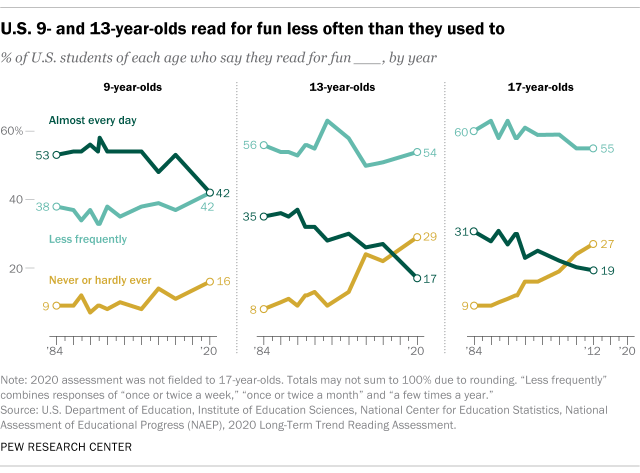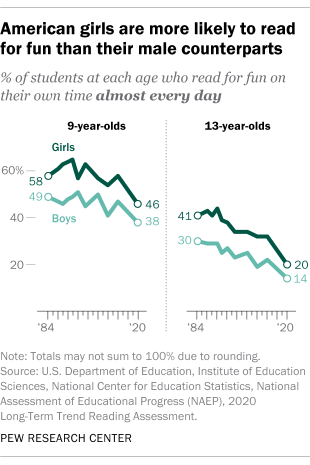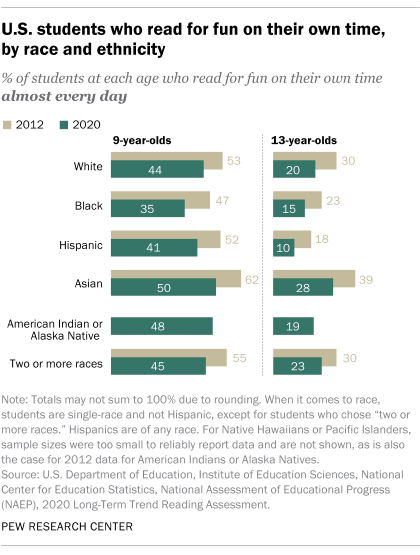
The shares of American 9- and 13-year-olds who say they read for fun on an almost daily basis have dropped from nearly a decade ago and are at the lowest levels since at least the mid-1980s, according to a survey conducted in late 2019 and early 2020 by the National Assessment of Educational Progress (NAEP).
Among both age groups, the percentages who said in the 2019-20 school year that they “read for fun on [their] own time almost every day” were at their lowest points since the question was first asked in 1984, according to the survey, which was fielded among U.S. public and private school students before the COVID-19 outbreak. It is unclear whether the pandemic may have changed these patterns.

To assess the reading habits of American children, this Pew Research Center analysis looks at how their frequency of reading for fun has changed over time.
The analysis draws on data from the long-term trend (LTT) assessment portion of the National Assessment of Educational Progress (NAEP). The LTT assessments are designed to track trends in the academic performance of American 9-, 13- and 17-year-olds over decades. Results from the 2020 LTT reading assessment are based on nationally representative samples of 8,400 9-year-olds (surveyed between January and March 2020) and 8,900 13-year-olds (surveyed between October and December 2019). More information about the assessment’s methodology, information on interpreting the results of the survey, and the questions used for the survey is available on the NAEP website.
When it comes to race, students are single-race and not Hispanic, except for students who chose “two or more races.” Hispanics are of any race.
Among 9-year-old students, around four-in-ten (42%) said in 2020 that they read for fun almost every day, down from 53% in both 2012 and 1984.
The share of 9-year-olds who said they never or hardly ever read for fun on their own time was at its highest point since the question was first fielded: 16% said this in 2020, compared with 11% in 2012 and 9% in 1984.
In 2020, a quarter of 9-year-olds said they read for fun once or twice a week, 9% said they do this once or twice a month, and 8% said they do this a few times a year.
Among 13-year-olds surveyed in the 2019-20 school year, 17% said they read for fun almost every day, a smaller percentage than the 27% who said this in 2012 and roughly half the share (35%) who said this in 1984. About three-in-ten students in this age group (29%) said they never or hardly ever read for fun, up 21 percentage points from the 8% who said the same in 1984.
Around a quarter of 13-year-olds (23%) said in the most recent survey they read for fun once or twice a week, while fewer than two-in-ten said they read for fun either once or twice a month or a few times a year (16% and 15%, respectively).
The NAEP’s questionnaire has historically asked 17-year-old students how often they read for fun, but that portion of the 2020 survey – scheduled to begin last March – was canceled when many schools moved instruction online at the beginning of the COVID-19 outbreak. When the question was last asked in 2012, just 19% of 17-year-olds said they read for fun almost every day. Around a quarter (27%) said they never or hardly ever read for fun.
In the 2020 survey of younger children, female students were more likely than male students to say they read for fun. Nearly half of female 9-year-old students (46%) said they read for fun almost every day, compared with 38% of male students of the same age. And two-in-ten 13-year-old female students reported reading for fun almost every day, while 14% of their male counterparts said they did so.
The share of both male and female students who say they read for fun almost daily has declined across both age groups since 1984. There was a 21-point decrease among 13-year-old girls and a 12-point drop among 9-year-old girls. There were 11- and 16-point decreases for 9- and 13-year-old boys, respectively.
When it comes to race and ethnicity, 9-year-old students who are Asian American, White or Hispanic were more likely to say they read for fun almost every day than were their Black peers in 2020. Around four-in-ten or more Asian (50%), White (44%) and Hispanic (41%) students said this, compared with 35% of Black students. Among 13-year-olds, 28% of Asian students said they read for fun almost every day, along with two-in-ten White students who said they do this almost every day. These shares are larger than the shares of Black (15%) and Hispanic (10%) students who said the same.
Students who performed better on the reading section of standardized tests in 2020 reported reading for fun more frequently. For example, half of 9-year-old students who scored at or above the 75th percentile on the 2020 reading component of the NAEP reported reading for fun on their own time almost every day, compared with 39% of 9-year-old students who scored below the 25th percentile.


